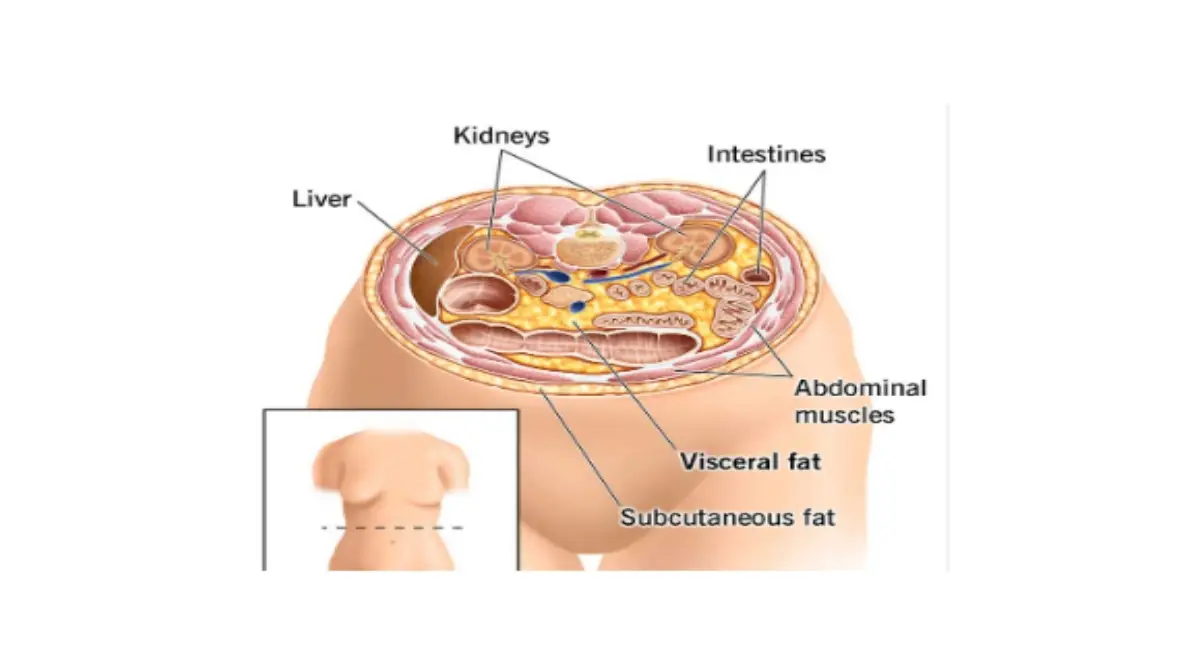Understanding the Nature of Visceral Belly Fat
When we talk about visceral belly fat, we’re referring to a specific type of fat stored deep within the abdominal cavity. Unlike the fat you can pinch on your arms or thighs, visceral fat surrounds internal organs like the liver, pancreas, and intestines. This placement makes it particularly hazardous, affecting not just appearance but also health in significant ways!
Understanding visceral fat is crucial because it is linked to various health problems. It’s often described as “active” fat since it produces hormones and other substances that can influence our body’s metabolism. This means that managing visceral fat is not just about looking good; it’s about boosting overall health!
Defining Visceral Fat and Its Characteristics
Visceral Belly Fat is distinct from other types of fat in several ways. It is more metabolically active and can release fatty acids and hormones into the bloodstream. Some characteristics include:
- Location: Found deep in the abdomen, wrapped around organs.
- Health Risks: Linked to conditions like heart disease and diabetes.
- Hormonal Effects: Produces hormones that can impact appetite and metabolism.
These characteristics help explain why maintaining a healthy level of visceral fat is essential. When it accumulates, it can lead to metabolic disturbances and increase the risk of chronic diseases.
Distinguishing Visceral Fat from Subcutaneous Fat
While Visceral Belly Fat is located deep inside the body, subcutaneous fat is the layer of fat stored just under the skin. Understanding the difference is important because they have different health implications. Here are some key differences:
- Location: Visceral fat is internal; subcutaneous fat is external.
- Health Impact: Visceral fat poses higher health risks compared to subcutaneous fat.
- Appearance: Subcutaneous fat can be seen and pinched, while visceral fat cannot.
Recognizing these differences can help you realize why focusing on reducing visceral fat is crucial for long-term health!
The Role of Hormones in Visceral Fat Accumulation
Hormones play a significant role in the accumulation of visceral fat. For instance, stress can lead to higher levels of cortisol, a hormone linked to increased fat storage. This is why managing stress can be key in controlling visceral fat!
Some other hormones involved include:
- Insulin: Can promote fat storage in the abdomen when levels are high.
- Estrogen: Lower levels after menopause can lead to more visceral fat.
- Leptin and Ghrelin: These hormones regulate hunger and energy balance.
By understanding how these hormones influence fat storage, you can work on ways to manage them effectively.
Health Implications of Excess Visceral Fat
Excess visceral fat can lead to serious health problems, making it essential to be aware of its implications. Not only does it affect your appearance, but it can also lead to a range of health risks that should not be ignored. Managing visceral fat is crucial for overall health!
By learning more about these risks, we can take proactive steps to reduce visceral fat and improve our health.
Key Health Risks Linked to High Levels of Visceral Fat
High levels of Visceral Belly Fat are associated with various health issues, which is why monitoring it is important. Some of the main risks include:
- Heart Disease: Increases the likelihood of heart problems.
- Type 2 Diabetes: Can lead to insulin resistance.
- High Blood Pressure: Often linked with excess belly fat.
Awareness of these risks can motivate us to adopt healthier lifestyle choices!
Understanding Visceral Fat as an Active Endocrine Organ
Did you know that visceral fat acts like an endocrine organ? It secretes hormones and other substances that can influence our metabolism and overall health. This means it’s not just a passive storage of energy but actively communicates with the body!
Some key functions include:
- Hormone Secretion: Produces hormones that affect appetite and metabolism.
- Inflammation: Releases substances that can cause inflammation.
- Insulin Sensitivity: Can affect how our bodies respond to insulin.
Understanding these functions helps highlight the importance of managing visceral fat effectively!
Insulin Resistance and Its Connection to Visceral Fat
There is a strong link between excess Visceral Belly Fat and insulin resistance. When we have too much visceral fat, it can lead to the body’s cells becoming less sensitive to insulin. This can cause a cycle of increased fat accumulation and health problems.
Key points about insulin resistance include:
- High Blood Sugar Levels: Can lead to diabetes.
- Increased Fat Storage: Promotes further abdominal fat accumulation.
- Health Complications: Increases the risk of heart disease and other conditions.
Recognizing this connection can help you focus on strategies to improve your insulin sensitivity!
Visceral Fat’s Role in Metabolic Syndrome and Cardiovascular Disease
Visceral fat is a key player in metabolic syndrome, a cluster of conditions that increase your risk for heart disease and diabetes. This syndrome is characterized by high blood pressure, elevated blood sugar, excess body fat around the waist, and abnormal cholesterol levels.
Some implications of Visceral Belly Fat in metabolic syndrome include:
- Increased Heart Disease Risk: Directly linked to higher levels of visceral fat.
- Higher Cholesterol Levels: Can contribute to cardiovascular problems.
- Overall Health Impact: Increases the chances of several chronic diseases.
Being aware of these connections allows us to take meaningful steps towards reducing visceral fat!
Measuring Your Visceral Fat Levels
Knowing your Visceral Belly Fat levels is an important step in managing your health. There are various ways to measure visceral fat, and understanding these methods can help you track your progress. The goal is to stay informed and proactive about your health!
Let’s dive into how we can effectively measure and monitor visceral fat levels!
Methods for Accurately Measuring Visceral Fat
There are several methods to measure visceral fat accurately. Some of the most common techniques include:
- CT Scans: Provide detailed images of fat distribution.
- MRIs: Also offer a clear view of visceral fat levels.
- Bioelectrical Impedance Analysis: Estimates body fat percentage using electrical currents.
Knowing which method works best for you can guide your health journey!
Using Waist Circumference and BMI as Indicators
Two simple measurements that can give you insight into your visceral fat levels are waist circumference and Body Mass Index (BMI). While not as precise as other methods, they are easy to track and can provide valuable information.
Here’s how to use them:
- Waist Circumference: Measure around the narrowest part of your waist.
- BMI: Calculate your weight in kilograms divided by your height in meters squared.
These indicators can help you identify if you’re at risk for health issues related to visceral fat!
Evaluating Body Composition and Its Importance
Understanding your body composition is crucial for assessing Visceral Belly Fat levels. Body composition refers to the proportion of fat and non-fat mass in the body. Evaluating it can help you create a targeted plan for improving health.
Some important factors to consider include:
- Fat Mass: The total amount of fat in your body.
- Lean Mass: Includes muscle, bone, and other non-fat tissues.
- Body Fat Percentage: A key indicator of overall health.
By regularly evaluating body composition, you can monitor changes and adapt your health strategies!
Key Takeaways on Managing Visceral Belly Fat
Managing visceral belly fat is essential for both physical appearance and overall health. To effectively reduce this type of fat, it’s crucial to adopt a comprehensive approach that combines several strategies. The key is to remember that small, consistent changes can lead to significant results!
Here are some effective approaches for visceral fat reduction that can help you get started:
- Balanced Diet: Focus on whole foods, reduce sugar intake, and control portion sizes.
- Regular Exercise: Incorporate both aerobic exercises and strength training into your routine.
- Stress Management: Employ techniques like meditation, yoga, or deep breathing exercises.
- Quality Sleep: Aim for 7-9 hours of sleep each night to promote fat loss.
Summarizing Effective Approaches to Visceral Belly Fat
In summary, the best results come from a combination of diet, exercise, and lifestyle changes. Tracking your progress can also be motivating and help you stay on target. Remember, it’s about making gradual changes that fit into your life.
Additionally, consider these strategies:
- Stay Hydrated: Drinking plenty of water can support your metabolism.
- Limit Alcohol Consumption: Reducing alcohol intake can significantly lower visceral fat.
- Regular Check-ins: Monitor your waist circumference and overall health regularly.
Encouraging Ongoing Health Management and Lifestyle Adjustments
Ongoing management of visceral fat is crucial for long-term health. Addressing your habits and lifestyle choices should be an ongoing effort rather than a quick fix. By continually making adjustments, you can maintain a healthy balance!
Here are some tips to encourage ongoing health management:
- Set Realistic Goals: Break your goals into smaller, achievable steps.
- Join a Support Group: Engaging with others can provide motivation and accountability.
- Educate Yourself: Keep learning about nutrition and health to make informed choices.
Engaging with Health Professionals
Consulting with healthcare providers is key when managing visceral fat. They can provide personalized advice based on your health status and goals. Don’t hesitate to reach out for help—you’re not alone in this journey!
Working with professionals can help you create a tailored plan that works for you. This can include dietitians, personal trainers, or even mental health professionals.
When to Consult Your Healthcare Provider for Guidance
If you’re struggling to manage visceral fat on your own, it’s important to seek guidance from your healthcare provider. They can assess your health and offer recommendations tailored to your needs. It’s best to consult them if you notice:
- Significant Weight Gain: Especially around the abdomen.
- Unusual Fatigue: Experiencing excessive tiredness can signal health issues.
- Blood Sugar Issues: If you have concerns about insulin resistance.
Resources for Further Information and Support
Numerous resources are available to help you on your journey toward reducing visceral fat. Websites, books, and even community programs can offer support and information. Here are a few valuable resources you might consider:
- Online Health Communities: Engage with others facing similar challenges.
- Nutrition Guides: Look for reputable sources that provide detailed meal plans.
- Fitness Apps: Utilize technology to track your progress and workouts.
Remember, taking action and seeking support is crucial in managing your visceral fat effectively. You got this!
Comparison of Visceral Fat and Subcutaneous Fat

Key Health Risks of High Visceral Fat Levels
Heart Disease: Increases risk of heart problems.
Type 2 Diabetes: Can lead to insulin resistance.
High Blood Pressure: Often correlated with excess belly fat.
Frequently Asked Questions (FAQs)
- What is visceral fat? Visceral fat is the fat stored deep within the abdominal cavity, surrounding vital organs. It is linked to various health issues.
- How does visceral fat differ from subcutaneous fat? Visceral fat is located deep within the abdomen, whereas subcutaneous fat is stored just under the skin.
- What are the health risks associated with high levels of visceral fat? High levels of visceral fat are associated with heart disease, type 2 diabetes, and high blood pressure.
- How can I measure my visceral fat levels? You can measure visceral fat through CT scans, MRIs, waist circumference, and BMI.
- What lifestyle changes can help reduce visceral fat? A balanced diet, regular exercise, stress management, and adequate sleep can help reduce visceral fat.







